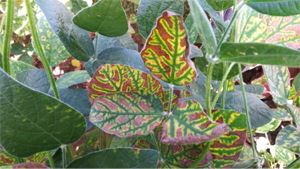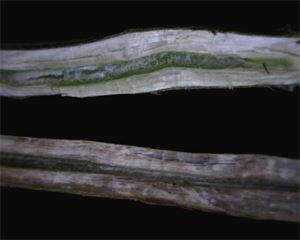Sudden Death Syndrome Of Soybean Found
DR. TERRY SPURLOCK
MONTICELLO, ARK.
Sudden death syndrome (SDS) was confirmed last Friday in Desha Co. The disease is caused by the fungus Fusarium virguliforme. The symptoms of the disease are most often seen after flowering when pods begin to form on the plant (even though the infection and colonization of the plant by the fungus occurred much earlier in the growing season). Symptoms are best described as a chlorotic mottling of the leaflets in between the veins. After time, these chlorotic areas become brown and necrotic (Fig 1.).
Severely affected plants defoliate and leafless petioles are left exposed in the field. The necrotic brown areas of the leaves or “flashing” is not necessarily an indication of SDS as leaves of plants affected by stem canker, charcoal rot, triazole burn, or the “mystery root rot disease” that we are finding in soybeans the last few years can produce similar foliar symptoms. For proper diagnosis, the lower stem and taproot of the plant must be split lengthwise. A plant with SDS should have brown streaks in the cortical tissue or brown cortical tissue. A plant without SDS should have white cortical tissue. The pith (central in the stem) should remain white in both diseased and non-diseased plants (Fig 2.).
Unfortunately, there are limited management options for SDS when it is discovered in a field. Because the disease originates from the root system, a foliar fungicide will not be effective. The areas of the field with disease have poorly functioning root systems; therefore, drought stress should be avoided. However, overwatering could increase the opportunities for other diseases and create more disease issues in parts of the field where SDS is not observed. Yield loss in the most affected areas can be severe and in some fields observed in 2014 reduced average yield by 30-40 Bu/acre.
Future management should involve the use of cultivars with some resistance to the disease. The fungus is well adapted to survive on residue from corn and soybean so an annual rotation with corn will not reduce disease. Other considerations should be to plant fields with a history of SDS later. Cooler and wetter soil conditions favor infection and colonization by the fungus that causes the disease. Additionally, evidence suggests SDS is more severe when soybean cyst nematode is present in the field. New seed treatment products, such as Ilevo (fluopyram), are labeled for control of SDS and may provide protection in fields where the disease has been a frequent problem. ∆
DR. TERRY SPURLOCK: Extension Plant Pathologist, University of Arkansas

Figure 1. Foliar symptoms of SDS.

Figure 2. Soybean plant unaffected by SDS (above) and a soybean plant with darkened and damaged cortical tissue from SDS (below). The pith of both plants remains white.